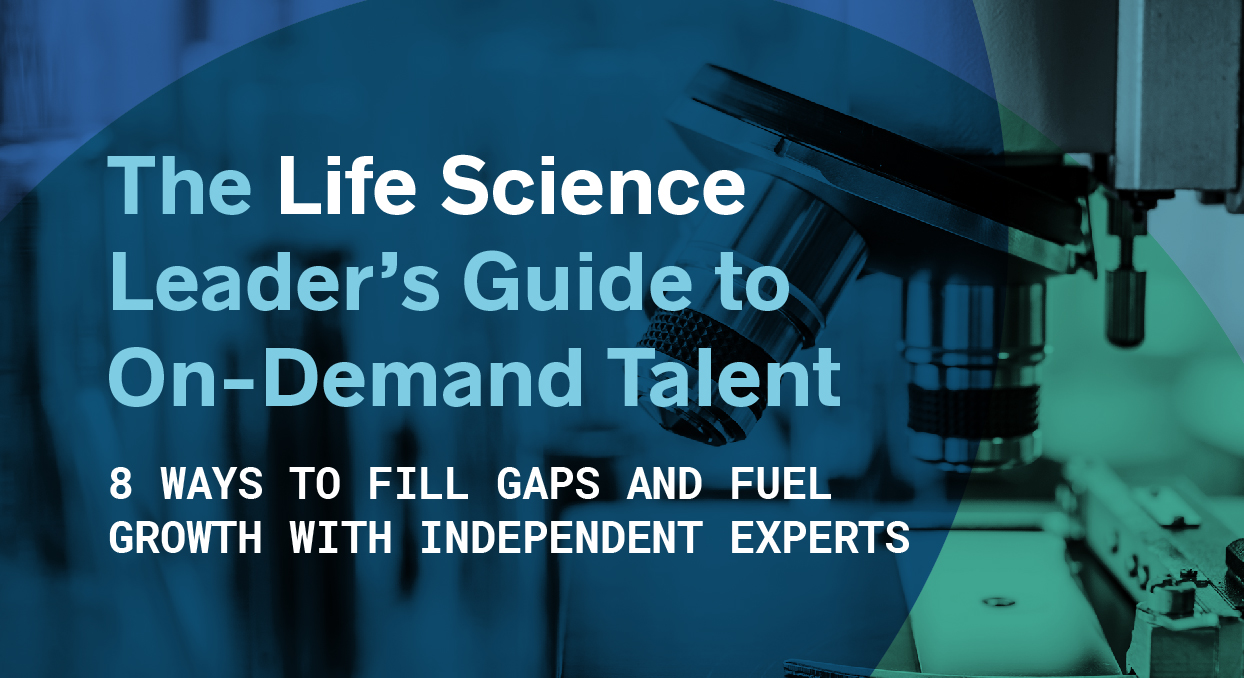
The life sciences industry occupies a unique position, in that it must be both highly competitive and highly collaborative. As a result, its challenges are also unique. Though supply chain fragility, cost pressures, and talent shortages are global pain points at the moment, a historic deprioritization of technological infrastructure has put life science operations at a significant disadvantage when it comes to agility and resilience initiatives.
Nothing illustrated this better than the beginning of the pandemic, when technology became the fulcrum upon which slow adopters teetered precariously. Some life science orgs embraced the sudden need to go deeper with tech, yielding improved product traceability and thrusting previously marginalized services (such as telemedicine) into the mainstream. Others, however, continue to struggle with the abundance of available technologies and how best to tap the opportunities that automation and digitization offer.
Sustainability is a similarly outsized concern due to the industry’s inherent focus on the betterment of life. This makes life science supply chain challenges all the more acute, as sustainability initiatives must be considered from both angles: operational and environmental. Without one, manufacturing resilience suffers; without the other, ESG resilience does.
Ultimately, all of these challenges unique to life science operations are further exacerbated by the global talent shortage. The speed at which the industry has evolved has left broad skills gaps, and while some larger companies have accelerated upskilling, the fact remains that life, physical, and social science occupations have the second-lowest unemployment rate of all US occupations. Talent is hard to find everywhere, but especially so in this sector.
Upskilling vs. Right-Sizing Talent
Upskilling has its advantages, but it takes time—something that’s a bit of a luxury in a rapidly expanding industry. Another issue is that upskilling requires both infrastructure and an existing skills base from which to draw. Though a select few of the largest life science companies may have the resources to support the former, it would be a quantum leap for most organizations. The latter is the bigger concern, as the intersection between technology and life science operations is where most growth needs to happen right now in order to strengthen resilience.
Where upskilling doesn’t apply, life science leaders are augmenting internal teams by bringing in independent talent. Though the larger talent market is tight, the availability of highly skilled independent talent has grown. Unfettered by geographic restrictions and armed with CVs rich in operational and consulting experience, these on-demand experts are stepping in to support strategic growth across the life sciences.
How Highly Skilled Independents Are Helping to Close the Gap
With more than 4,600 highly skilled life science talent in its cohort—half of whom also possess operational experience—Business Talent Group (BTG) has gotten a first-hand look at the tactical ways in which independent experts are currently being deployed. Five areas, in particular, jump out when assessing the life science operational landscape:
- Tech enablement and organizational effectiveness, such as strategic and operational change management for developing an integrated digital ecosystem
Once the industry’s Achilles’ heel, digital integration has become a foundational priority for life science companies. “By modernizing their core technology,” a recent report from McKinsey asserts, “life-science companies have a distinct opportunity to gain true competitive advantage over peers.”
This assertion is further bolstered by McKinsey’s findings that “digital maturity is associated with better business outcomes (for example, five times the revenue compound annual growth rate and better delivery of products).” Yet knowing the benefits and having the resources in place to reap them are two different things. Enter: on-demand expertise.
By nature, digital transformations are complex, and both planning and execution are equally critical. Independent life science consultants not only have applicable expertise; many also have project management and systems implementation expertise.
In one case, a global healthcare company needed support on a multinational master data management transformation. The former PwC consultant whom BTG engaged for the project provided the company with process maps and Fit Gap analyses for 21 markets across all functions, and also prepared, arranged, and coordinated change impact assessments as well as implementation and track mitigation plans. When he was finished, the company was able to move forward confidently, and the consultant was free to move on to the next project.
Tactical and strategic expertise to guide initiatives including supply chain market assessment, planning, and optimization; supply process transformation; and operations readiness
Life science supply chain challenges carry risks beyond the bottom line. Bottlenecks can be truly dangerous, as delays can prevent life-saving medicine and devices from reaching vulnerable individuals. BTG supply chain operations expert Marcos Buelvas says the supply-side constraints experienced early in the pandemic revealed additional underlying risks that warranted direct, and swift attention:
“Structurally, it is clear that risk is (and should have always been) a major driver of decision making. Decisions around dual supply, near-shoring, and localized capacity have become part of everyone’s language and should stay there so that we are better prepared to manage known and unknown risks, and appropriate plans should always be detailed and understood within and across organizations.”
Again, however, knowing and doing are two different things. Supply chain fragility was laid bare for all to see, but without next steps in place, those weaknesses—and risks—remain. That’s why this is another area where we are seeing on-demand consultants brought in to think through supply chain design and create a cost-effective, sustainable plan for implementation.
“Independent supply chain experts like myself bring a wealth of diverse experiences that can supplement those of our clients,” Buelvas says. “It starts with how the organization sources and who it partners with in that space to reduce risk. It then extends to our manufacturing strategy, both internally and with external partners. And it ends with distribution and how we ensure we can meet customer and patient expectations.”
Pre-commercial planning and development activities, including market research and competitive analysis, product and portfolio development, and ESG/sustainability and disaster planning
While supply chain transformation leans more heavily on cooperative relationships, pre-commercial planning and development in the life science sector veer hard into competitive territory. With the introduction of innovative new treatments increasing rapidly across the life sciences, it’s no wonder that companies are trying to ensure that promising products are ready to hit the ground running as soon as they are approved for patients’ use.
From the patient’s journey and the payer’s perspective to the therapeutic and regulatory landscapes, traditional consulting firms have the ability to help identify obstacles throughout the product development process. Yet independent consultants possess the ability to both advise and execute, and many are also former life science executives, giving them functional insight into what works and what doesn’t.
For example, when a clinical stage biotech company was developing an innovative product with wide-ranging medical applications, the Chief Medical Officer needed help moving the product from phase 2 to phase 3.
BTG paired the client with a manufacturing expert who was able to provide recommendations on process improvements and commercial manufacturing. They assessed the supply chain situation and existing limitations and created a method qualification/validation plan, reviewed current final release assays, and made recommendations on how to prepare for the next phase.
Product and process development / design, such as design controls, new product and lifecycle management planning, cost matrix analysis, QMS decisions, and digitization and automation of quality processes
In talking about the growing role of AI in life science operations, Marcos Buelva says, “I am not overreaching when I say that it is everywhere. AI is about evaluating multiple data sources and providing options or recommendations on the decisions to be made.”
AI can be applied to great effect in supply chain strategy as well as product and lifecycle management planning—but only if it has sufficient, reliable data to work with. What’s more, executing on AI-generated recommendations and automating quality processes still requires implementation planning and process design consideration. Internal teams may lack the expertise to effectively identify—let alone clean—the necessary data, and they might also lack the tech-savviness to design an effective automation process.
Independent consultants at the intersection of data analysis and digitization bring the ideal blend of talent to these types of life science product and process development projects. For example, when an F500 medical device company needed to automate its scenario analysis and data visualization processes, BTG paired the client with a former McKinsey consultant. The consultant brought their experience from past analytics-focused engagements to create an Excel model that would feed a digital optimization tool and create data visualizations. The final deliverable also included a deck with next steps for the overall initiative workflow and project plan.
Launch, management, and support activities such as product and tech transfer planning and execution, manufacturing excellence, risk reduction, and manufacturing network resilience
The combination of a tight labor market and soaring costs has put additional strain on teams, leading many to be stretched whisper-thin. Given the myriad risks already involved in a life science product launch, falling behind schedule is a threat that looms large. Fortunately, on-demand experts can integrate quickly and easily into internal teams, whether providing support for ramp-ups or removing roadblocks along the way.
This was precisely the case when the Senior Value Stream Project Manager of a global healthcare company needed critical project management support while ramping up capability for worldwide production of a COVID-19 vaccine. Their primary concern was staying on schedule while simultaneously pushing development forward.
BTG was able to provide a former Accenture consultant with extensive project management, change management, supply chain, and logistics expertise across the pharmaceutical and medical device industries. By participating in team meetings, the consultant was able to keep things on track. He stepped in to support several technical transfers, facility ramp ups, and expansions, and also provided dashboard design automation, communications presentations, meeting oversight, and risk register maintenance.
Challenges abound in the global market landscape, but perhaps none appear more frequently than in the life science industry. At the same time, challenges often give way to unprecedented opportunities, and it’s the life science leaders that make the most of this critical moment that will come out ahead. The key lies in securing the necessary expertise without relying on a geographically constrained and talent-scarce labor market.
BTG’s marketplace features thousands of independent life science talent with broad operations expertise and specific in-demand skills that can help assist with the opportunities and challenges of both pre-commercial and commercial activities. If you could use support with product development, clinical supply, quality automation, regulatory compliance, supply chain resilience, and/or manufacturing excellence, reach out today.
GET THE SKILLS YOU NEED
Thousands of independent consultants, subject matter experts, project managers, and interim executives are ready to help address your biggest business opportunities.
About the Author
More Content by Emily Slayton












